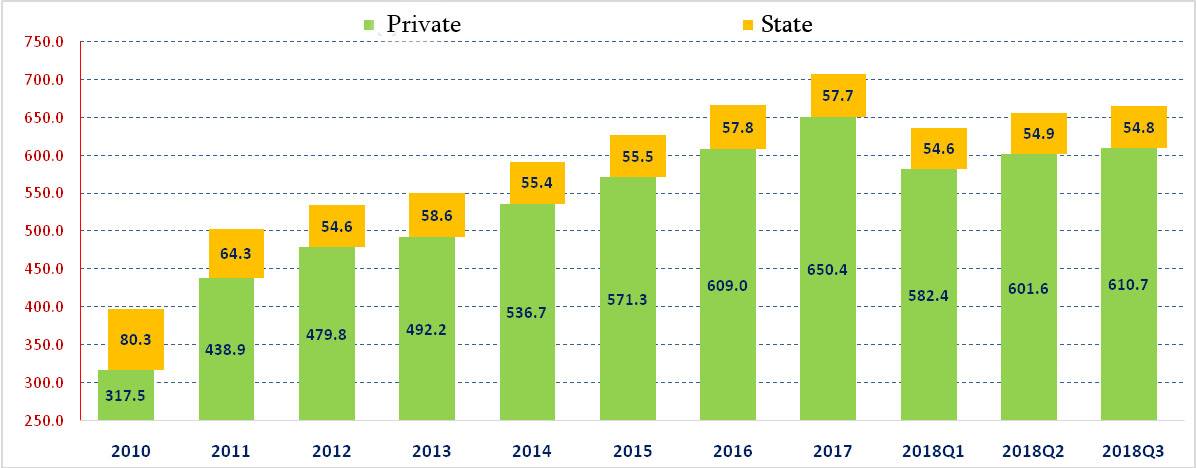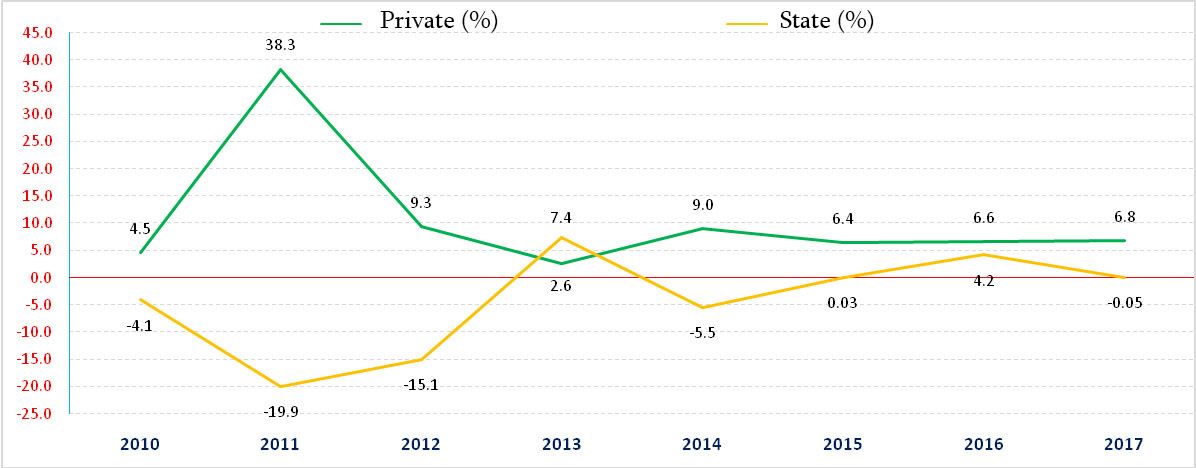Resume: As part of business sector statistics, National Statistics Office of Georgia gauges number of jobs both in private and state enterprises based on information provided by the enterprises. In accordance with that data, number of jobs in the private sector increased by 158,200 in 2013-2017, whilst employment in the state enterprises dropped by 0,9 thousand in the same period. In the given period, annual job growth rate in the private sector is 6.3% on average. Prior to 2013, job creation was higher in the private sector, whilst job decrease rate in the state enterprises was also faster.
Despite the fact that the number of jobs in enterprises increased by 28.6% in 2013-2016, the amount of people involved in hired labour has been increased by 18.8% only. Therefore, job growth rate does not match with growth in hired labour. The explanation is that one and the same person has multiple jobs simultaneously.
Analysis
The Deputy Speaker of the Parliament of Georgia, Giorgi Volski, spoke about employment on air on Rustavi 2. As stated by the MP, jobs have a tendency of growth, albeit this growth is marginal.
Business sector statistics, published by National Statistics Office of Georgia, includes statistical information about jobs. This data encompasses the number of jobs both in private and state enterprises.[1] National Statistics Office of Georgia compiles these statistics based on information provided by the enterprises themselves.
In 2017, total amount of job in both private and state enterprises amounted 708,200. Of that amount, 650,400 (91.8%) are jobs in the private enterprises. In the past years, number of jobs has been increasing annually by 34,200 on average. However, in the three quarters of 2018, that figure did drop. In the first quarter of 2018, number of jobs shrank by 71,100 as compared to the annual figure of 2017. In the first quarter, an actual reason behind that could be a seasonal factor, although as compared to 2017, in the second and third quarters of 2018 that figure is 51,600 and 42,700 less respectively.
Graph 1: Number of Jobs in State and Private Enterprises (Thousand Persons)

Source: National Statistics Office of Georgia
In terms of annual growth of jobs in private enterprises, 2011 has been a distinguished year (38.3%). In 2011, number of jobs in state enterprises decreased by 19.9%. The aforementioned changes are possibly stipulated by massive privatisation of hospitals (54 hospitals). In 2015 and 2017, number of jobs in state enterprises did not really change, whilst in 2013 and in 2016, on the contrary – it increased. In 2013, number of jobs in state enterprises increased by 7.4% as compared to the previous year, whilst in the same period job growth in private enterprises was low at 2.6%. In regard to 2016, in that period number of jobs in state enterprises increased by 4.2%, whilst growth in private enterprises constituted 6.6%.
Given the fact that Giorgi Volski speaks about achievements, it would be appropriate to discuss the trends since 2013. In 2013-2017, annual average growth rate of number of jobs in private enterprises is 6.3%. In the same period, number of jobs in private sector increased by 152,800 (32.1%) in total, whilst number of jobs in state enterprises decreased by 0.9 thousand, that is by 1.6%. In addition, prior to 2013, job growth in private enterprises was higher and job loss in state enterprises was faster as compared to post-2013 period.
Graph 2: Job Growth Rate in State and Private Enterprises (%)

Source: National Statistics Office of Georgia
As illustrated by the graphs, in total, number of jobs increase. This includes job growth in private enterprises and job loss in state enterprises. Despite this, aforementioned statistical data do not indicate growth in number of employed people, because amount of jobs does not equal the same number of employed individuals. A person, who is able to work, can be working in two different jobs and there are many cases of that. For instance, a person who is an accountant in several different enterprises simultaneously is registered as many times in the aforementioned statistics, as the number of jobs he/she has. In fact, however, only one person is employed and the number of jobs is not the same as the number of employed individuals.
Second instance could be an individual, who has a job in enterprise and pursues pedagogical work at the same time. This kind of individual is registered twice in the statistics. Therefore, of interest is employment/unemployment statistics, which is compiled by National Statistics Office of Georgia based on workforce research and which is given in graph 3.
Graph 3: Unemployment/Employment Statistics (Thousand Persons, %)

Source: National Statistics Office of Georgia
As of 2017, there are 1,706,600 employed individuals in Georgia, which constitutes 56.7% of people able to work. In 2013-2017, this figure increased by 3.8%, that is by 63,200 employed persons, whilst share of employed individuals (share of employment) among people able to work increased by 2.5 percentage points.
[1] It does not include non-entrepreneurial (non-commercial) legal entities of the public law and legal entities of the public law.








